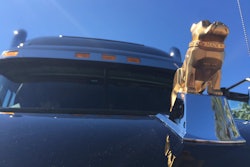This blog was provided exclusively to CCJ by Joe Puff, vice president of truck technology and maintenance, NationaLease
When you talk about maintenance best practices, the conversation needs to start with a look at specifications.
 Joe Puff, vice president of truck technology and maintenance, NationaLease
Joe Puff, vice president of truck technology and maintenance, NationaLeaseTechnology in the trucking industry has changed dramatically over the last several years. In order to spec the right truck for the application, you need to know a lot more information than you did just a few years ago. Now, fleet owners and managers must be able to assess the total life cycle cost of each vehicle in order to truly optimize their fleet. Selecting the right vehicle, components, and ECM settings is critical to this mission, and it doesn’t just happen by chance. Start by ding a thorough application and duty cycle needs analysis.
There are many things to consider when assessing total vehicle life cycle costs including idle time, distance between stops, percent of time fully loaded, electrical/air supply demands, the balance of fuel economy vs. performance, safety technologies, terrain, and much more.
With so many component options available to meet the specific duty cycles and application needs, how do you choose the one that’s right for you? The right selection can considerably reduce fuel and maintenance costs; however, the wrong selection could prove catastrophic. Choosing a technology that helps save on fuel costs may sound perfect, but put in the wrong application, that technology could, in fact, have a profoundly negative affect on maintenance costs.
Although reducing the vehicle acquisition investment is a goal, fleet managers should always feed the following into the equation: reliability, downtime, maintenance costs, fuel and CSA expenses, driver acceptance, resale value, and on-time delivery. Negative outcomes in these areas can far outweigh a few thousand dollars that you may save up front.
Here are a few recommendations
- ECM settings can significantly impact both fuel efficiency and maintenance costs; estimates can range as high as 3 percent to 7 percent fuel savings. Many of the settings are basic, like progressive shifting, torque limiting, cruise control options, idle shut downs, auto elevate, etc. Other settings can be much more complex and may or may not be necessary. What is critical is for fleet professionals to understand the demand and to set the parameters for a specific application.
- In general, OEMs spec batteries and alternators to meet the demands of the cab and chassis, and a little extra. But, things can change when you add in other power demands like a high liftgate cycle count, high APU demand, or lights which are required to be left on during unloading. The situation is compounded even further when high electrical demands are matched with shortened drive times between stops. The result is more power being removed from the batteries than going back in.
Batteries can only take a certain number of deep cycle discharges and then they will fail — how many depends on the battery type and quality. The result of mis-spec’ing an electrical system may not show up for a year or so and can sometimes be mistakenly blamed on a poor maintenance practice or a defective battery. It doesn’t take too many failed batteries, road calls, or upset customers throughout a vehicle’s life cycle to justify upgrading the electrical system. A few hundred dollars spent on upgrading electrical components up front can end up saving thousands later on in maintenance costs, downtime and substitute vehicle expenses.
- Make sure you have the right extended warranty for the situation. It won’t take too many shop visits to offset the investment of many extended warranty packages. In general, extended warranties may hold less value when it comes to less demanding duty cycles and mileage applications; however, when it comes to high demand applications, the warranty can be much more valuable. When considering an extended warranty package, consider the duty cycle, load demand, stop-and-go vs. line haul, terrain, and away-from-home service options.
Making the right decisions up front will save you in cost and time later on.












